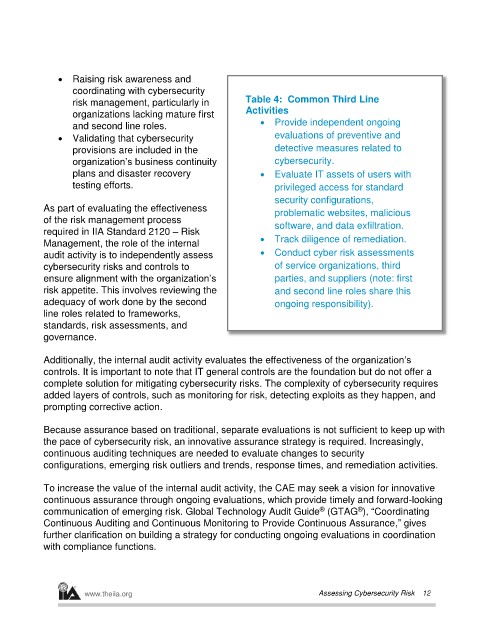Page 316 - ITGC_Audit Guides
P. 316
Raising risk awareness and
coordinating with cybersecurity
risk management, particularly in Table 4: Common Third Line
organizations lacking mature first Activities
and second line roles. Provide independent ongoing
Validating that cybersecurity evaluations of preventive and
provisions are included in the detective measures related to
organization’s business continuity cybersecurity.
plans and disaster recovery Evaluate IT assets of users with
testing efforts. privileged access for standard
security configurations,
As part of evaluating the effectiveness problematic websites, malicious
of the risk management process software, and data exfiltration.
required in IIA Standard 2120 – Risk
Management, the role of the internal Track diligence of remediation.
audit activity is to independently assess Conduct cyber risk assessments
cybersecurity risks and controls to of service organizations, third
ensure alignment with the organization’s parties, and suppliers (note: first
risk appetite. This involves reviewing the and second line roles share this
adequacy of work done by the second ongoing responsibility).
line roles related to frameworks,
standards, risk assessments, and
governance.
Additionally, the internal audit activity evaluates the effectiveness of the organization’s
controls. It is important to note that IT general controls are the foundation but do not offer a
complete solution for mitigating cybersecurity risks. The complexity of cybersecurity requires
added layers of controls, such as monitoring for risk, detecting exploits as they happen, and
prompting corrective action.
Because assurance based on traditional, separate evaluations is not sufficient to keep up with
the pace of cybersecurity risk, an innovative assurance strategy is required. Increasingly,
continuous auditing techniques are needed to evaluate changes to security
configurations, emerging risk outliers and trends, response times, and remediation activities.
To increase the value of the internal audit activity, the CAE may seek a vision for innovative
continuous assurance through ongoing evaluations, which provide timely and forward-looking
®
®
communication of emerging risk. Global Technology Audit Guide (GTAG ), “Coordinating
Continuous Auditing and Continuous Monitoring to Provide Continuous Assurance,” gives
further clarification on building a strategy for conducting ongoing evaluations in coordination
with compliance functions.
www.theiia.org Assessing Cybersecurity Risk 12

